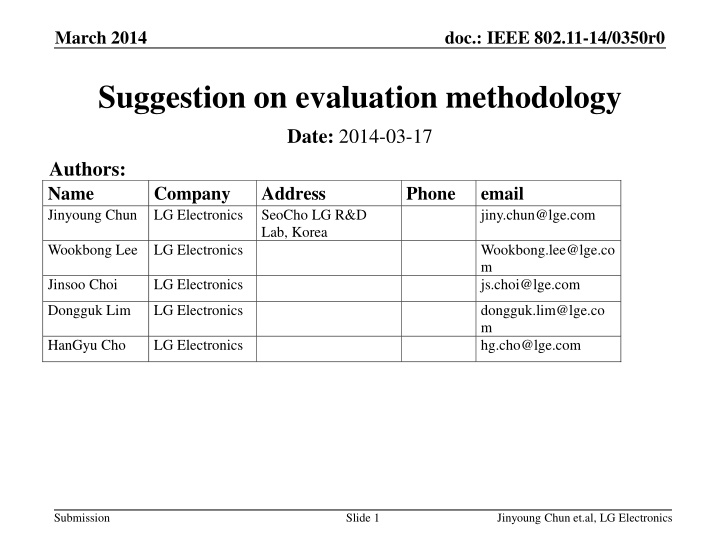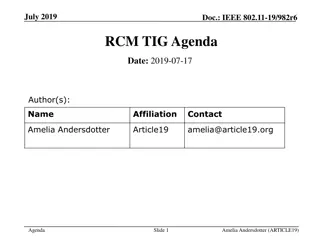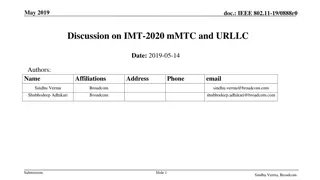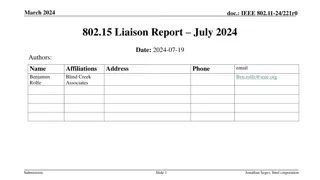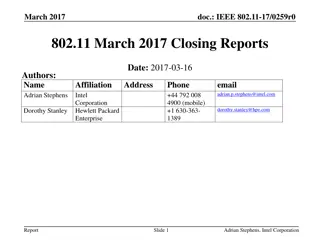Evaluation Methodology for IEEE 802.11-14/0350r0 in March 2014
In March 2014, LG Electronics proposed an evaluation methodology for IEEE 802.11-14/0350r0 to address users unable to support MCS0. The evaluation compared schemes for handling low SINR users, presenting simulation results for different options. The approach focused on optimizing throughput and BSS idle portion while addressing practical challenges in real-world scenarios.
Download Presentation

Please find below an Image/Link to download the presentation.
The content on the website is provided AS IS for your information and personal use only. It may not be sold, licensed, or shared on other websites without obtaining consent from the author.If you encounter any issues during the download, it is possible that the publisher has removed the file from their server.
You are allowed to download the files provided on this website for personal or commercial use, subject to the condition that they are used lawfully. All files are the property of their respective owners.
The content on the website is provided AS IS for your information and personal use only. It may not be sold, licensed, or shared on other websites without obtaining consent from the author.
E N D
Presentation Transcript
March 2014 doc.: IEEE 802.11-14/0350r0 Suggestion on evaluation methodology Date: 2014-03-17 Authors: Name Jinyoung Chun LG Electronics Company Address SeoCho LG R&D Lab, Korea Phone email jiny.chun@lge.com Wookbong Lee LG Electronics Wookbong.lee@lge.co m js.choi@lge.com Jinsoo Choi LG Electronics Dongguk Lim LG Electronics dongguk.lim@lge.co m hg.cho@lge.com HanGyu Cho LG Electronics Submission Slide 1 Jinyoung Chun et.al, LG Electronics
March 2014 doc.: IEEE 802.11-14/0350r0 Motivation In evaluation, we see that some users can t support even MCS0 as shown in the next slide. Since those users may not be able to be associated in real world, they have to be well handled in evaluation such that they do not cause impractical results. We compare some schemes to handle those users in evaluation and propose one. Submission Slide 2 Jinyoung Chun et.al, LG Electronics
March 2014 doc.: IEEE 802.11-14/0350r0 SINR in outdoor large BSS scenario PDF of SINR distribution in 5 seconds simulation time MCS0 MCS8 Portion of users under MCS 0 DL SIMO 0.86% DL STBC 0.32% UL SIMO 29.0% UL STBC 16.3% As shown in the above, about 30% of users in UL SIMO and 16% of users in UL STBC have SINR under MCS level 0. Submission Slide 3 Jinyoung Chun et.al, LG Electronics
March 2014 doc.: IEEE 802.11-14/0350r0 Options to handle low SINR users Temporally, we denote users with SINR under MCS0 in UL or DL as low SINR users. Option 1: Set low SINR users to MCS0 Option 2: Consider low SINR users unassociated Low SINR users are excluded in evaluation. Option 3: Re-drop until zero low SINR users [4,5] Since this is not fit with real world, we exclude this option in the following simulations. In the following slides, we see the simulation results of Option 1 and Option 2 in outdoor large BSS scenario. Submission Slide 4 Jinyoung Chun et.al, LG Electronics
March 2014 doc.: IEEE 802.11-14/0350r0 Simulation results (1x2 SIMO) Option 1 Option 2 DL Tput (Mbps) 10.3 12.6 Reported DL MCS levels (%) UL Tput (Mbps) 10.6 14.4 Reported UL MCS levels (%) Total Tput 27.0 20.9 BSS idle portion1) (%) In option2, throughput is higher and BSS idle portion is also higher because many low SINR users are excluded. 3.55 50.14 1) BSS idle portion: average portion that all devices in a BSS is idle Submission Slide 5 Jinyoung Chun et.al, LG Electronics
March 2014 doc.: IEEE 802.11-14/0350r0 Simulation results (2x2 STBC) Option 1 Option 2 DL Tput (Mbps) 10.3 11.2 Reported DL MCS levels (%) UL Tput (Mbps) 16.1 25.2 Reported UL MCS levels (%) Total Tput 36.4 26.4 * BSS idle portion (%) 3.55 21.98 The tendency is similar with the previous slide. Submission Slide 6 Jinyoung Chun et.al, LG Electronics
March 2014 doc.: IEEE 802.11-14/0350r0 Suggestion We discussed the low SINR user handling issue for evaluation methodology We propose to add the following text in the evaluation methodology document. Define a user with SINR under that of MCS0 by un- associated user . Exclude unassociated users in evaluation. For the purpose of information, provide the percentage of unassociated users in evaluation. Submission Slide 7 Jinyoung Chun et.al, LG Electronics
March 2014 doc.: IEEE 802.11-14/0350r0 Straw poll Do you support to add the text on low SINR user handling in slide 7 to evaluation methodology document? In Favor: Opposed: Abstain: Submission Slide 8 Jinyoung Chun et.al, LG Electronics
March 2014 doc.: IEEE 802.11-14/0350r0 Reference [1] 11-13-1359-00-0hew-hew-evaluation-methodology [2] 11-13-1001-06-0hew-simulation-scenarios-document-template [3] 11-14-0353, Suggestion on PHY Abstraction for Evaluation Methodology , LG Electronics [4] 11-14-82, improved-spatial-reuse-feasibility-part-i , Broadcom [5] 11-14-83, improved-spatial-reuse-feasibility-part-ii , Broadcom Submission Slide 9 Jinyoung Chun et.al, LG Electronics
March 2014 doc.: IEEE 802.11-14/0350r0 Appendix. Simulation parameters Simulation scenario Outdoor Large BSS scenario Tx/Rx power 30/15dBm # of users 50 Simulation time Initial: 2s, main: 20s, drop: 1 BW 2.4GHz, 20MHz (64 FFT) 1ms TXOP less fixed overhead (RTS/CTS off) - Normal overhead: SIFS + ACK + 2*PLCP header - Feedback overhead: ACK frame with feedback (<1symbol = 4us) Data size GI Long (0.8 us) Antennas for AP & STA Rank1: SIMO, STBC (interference model: AWGN) Max # of retries 10 DL & UL traffic Full buffer (DL & UL ratio: based on PHY system simulation in [2]) Preamble detection: -82dBm (both AP and STA) Energy detection: -62dBm (both AP and STA) CCA level Channel Time-varying SINR margin 0.5dB steps PHY abstraction MMIB [3] with extension to 256QAM (MCS8) Submission Slide 10 Jinyoung Chun et.al, LG Electronics
